Amber Fort Jaipur: A Complete Travel Guide
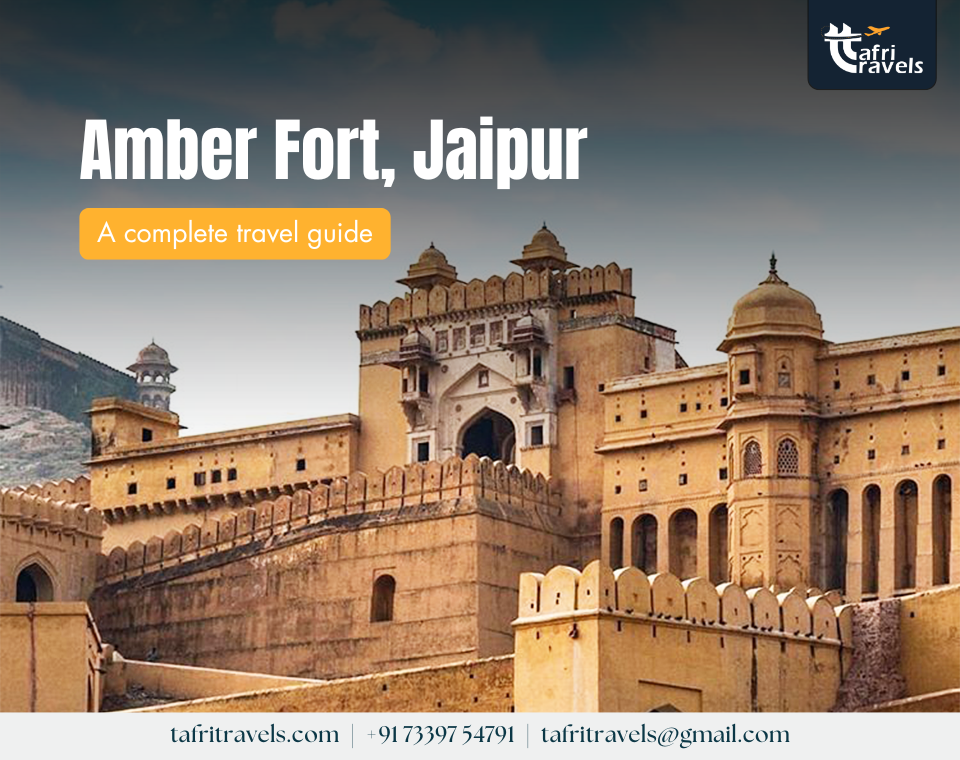
Amber Fort Jaipur: A Complete Travel Guide
Amber Fort Jaipur stands as one of the most historic forts in the heart of Rajasthan. Builders used red sandstone and marble to construct it across four levels, each with a courtyard. This is becoming more beautiful as time passes. This is the finest combination of Rajput and Mughal styles of old architecture, which is a UNESCO World Heritage Site and an imaginary place of pastel sandstone of white marble, enchanting courtyards, gardens to frolic within, and some very stunning-looking gates in the state.
Table of Contents
ToggleHistory
Amber Fort Jaipur also known as Amer Fort was established in 967 AD and it was originally built by Raja Man Singh I, who was the former Kachwaha Rajput ruler, in the late 16th century. Amer Fort stands atop a hill in Amer, 11 kilometers away from Jaipur, Rajasthan. Over 150 years, Marwari Rajputana rulers expanded Amber Fort, adding magnificent architecture that enhanced its beauty and fame. The Amber Fort was declared a UNESCO World Heritage site in 2013 as part of six hill forts in all parts of Rajasthan, with the architectural fusion of Rajput and Mughal styles.
Location
Amber Fort is about 8 miles, or 20 minutes, northeast of Jaipur’s city center in the heart of Rajasthan.
Reaching there
By Road:
- Auto-Rickshaw: Hire a private taxi or auto-rickshaw for a budget-friendly ride, and negotiate the fare to match your budget before starting your journey.
Through Public Transport:
- Bus: Catch a public bus to Amer from various Jaipur locations, and check schedules and routes in advance for a smooth trip.
Using Elephant or Jeep:
- Elephant Ride: One exciting way to reach Amber Fort is by taking an elephant ride from the foothills, offering a unique view.
- Jeep ride: It is the most exciting way to reach the fort.
By Foot:
- Trekking: This is for all the adventurous travelers, as there is an option to trek up to the Amber Fort because the hike is relatively steep but offers amazing views on the way.
Must See: Top Places to Visit in Jaipur in 2025
Timings of Amber Fort
Amer Fort opens at 8:00 AM and closes at 5:30 PM in summer, with timings varying by season.
In winter, it opens in the morning around 9:00 AM and closes at 5:00 PM.
Jaipur hosts various cultural events, and several people choose to stay at the Amber Palace for the evening sound and light show and a gala dinner. The fort reopens again, evocatively illuminated, from 6:30 until 9:15 p.m., depending on the season of that particular time.
Dine at 11:35 AM inside Amber Palace to enjoy a regal ambiance. The fine dining restaurant is located on level two of Jaleb Chowk. It stays open until around 10:30 PM every night. The menu offers a wide variety of authentic and delicious Indian cuisine. The food is so tempting, it’s hard to say no.
Tickets and cost
For Indian tourists:
Entry Fee: It is around INR 100 to INR 200 per person, depending on whether we choose to visit only the fort or include access to the palace inside the fort to see everything.
For foreign tourists:
Entry Fee: it is around INR 500 to INR 1000 per person, which typically includes entry to both the things like fort and the palace complex.
We need to keep in mind that entry fees can change over time, and there may be variations for special categories that include students, senior citizens, or large groups.
Also Checkout: Best Places to Visit in Rajasthan in 2025
What to see at Amber Fort Jaipur
These are the must-visit attractions inside Amber Palace that offer a glimpse into its historical evolution by showcasing the architectural brilliance and royal lifestyle of the Kachwaha dynasty.
Ganesh Pol (Ganesh Gate)
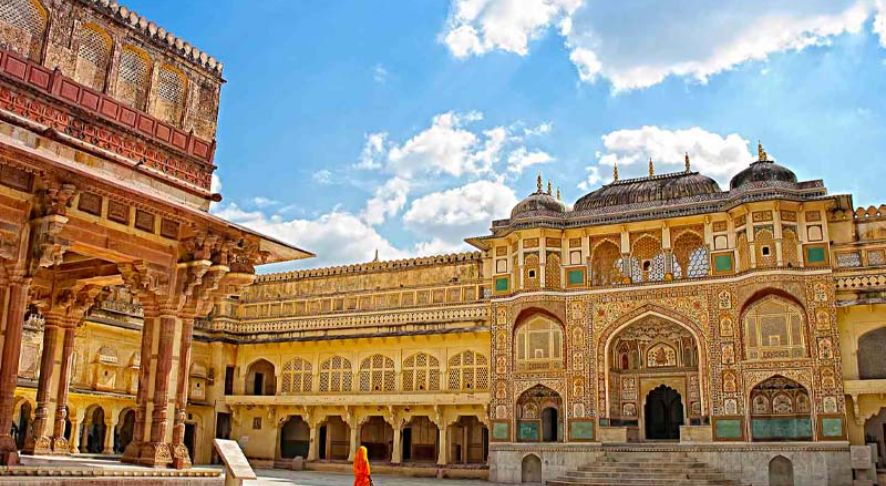
Ganesh Pol stands as the most magnificent gateway, uniquely adorned with frescoes and creative artwork, serving as the palace’s main entrance. The Kachwaha rulers designed this grand complex of gates to showcase their royal grandeur and used it exclusively for personal access.
Sheesh Mahal (Mirror Palace)
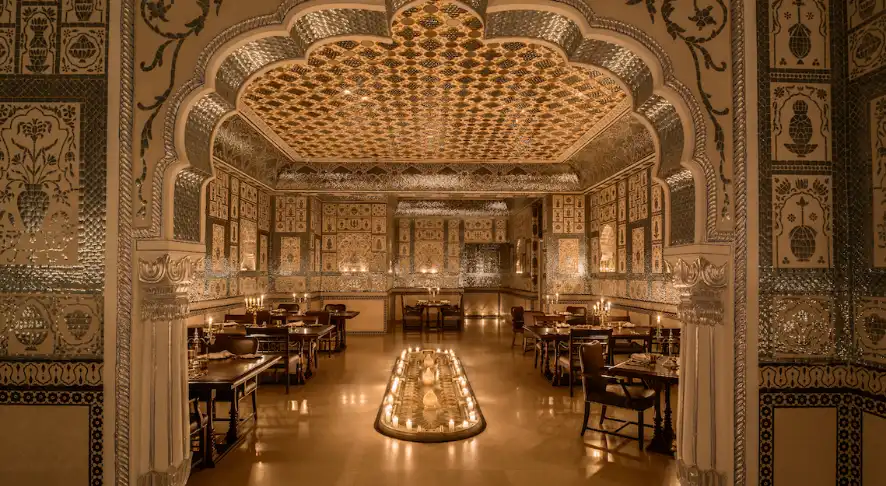
Artisans built this beautiful palace during the royal reign and adorned it entirely with shaped mirrors and colored glass, creating a mesmerizing play of light. They designed the symmetrical mirrors to amplify the glow of a single candle, producing a magical starlit night effect.
Diwan-i-Khas (Hall of Private Audience)
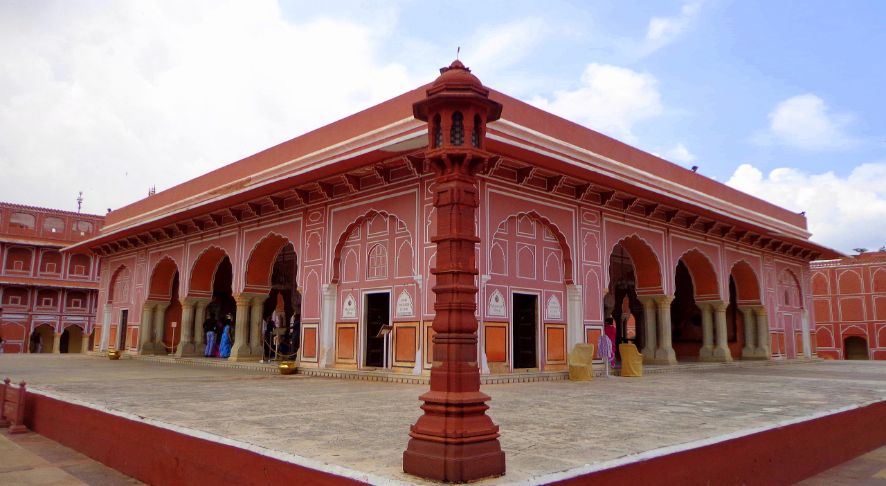
This beautiful, ornate hall features delicate frescoes and a stunning two-tiered marble pavilion where the king would love to meet with important guests. The huge carved and painted hall was used for private audiences with the king and important discussions. The miniature of glass was imported from all possible ways from Belgium.
Sukh Niwas (Hall of Pleasure)
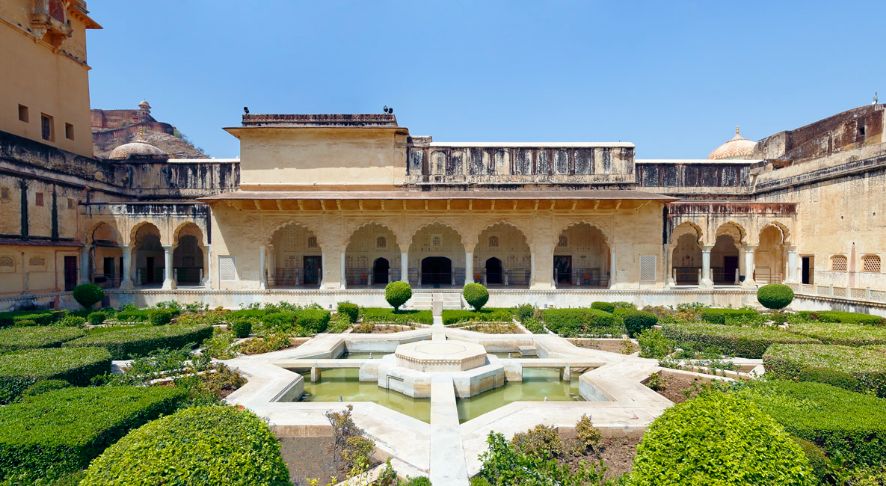
This old place features a wide cooling system of water channels and fountains designed to provide relief from the hot weather, which also served as a relaxation area for the royal family during the scorching summers of Rajasthan. This was kept cool during the time of summer by artificial winds that would blow on the top of the water cascade inside the palace.
Kesar Kyari Bagh (Saffron Garden)
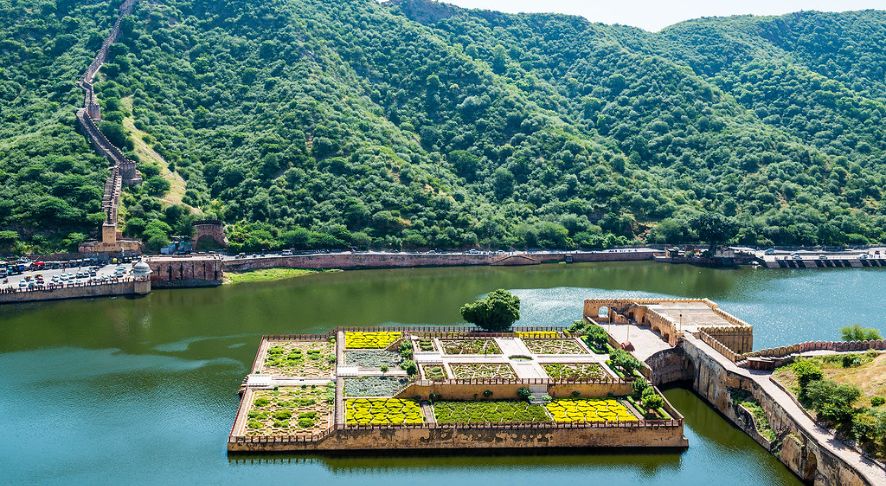
The Maharajas designed this garden in a geometric pattern and planted saffron star-shaped flowers around a star-shaped island in Maota Lake. The kings of ancient times surrounded it with vibrant blooms, adding royal charm to its beauty.
Shila Devi Temple
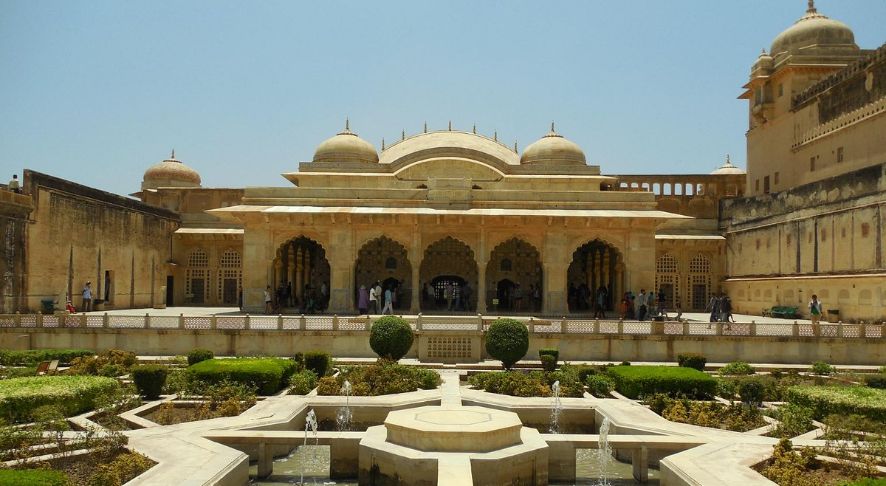
The Shila Devi Temple stands within the palace complex, where devotees worship goddess Kali and admire its intricate silver doors. It holds religious importance, and devotees visit it to seek blessings, and most of the devotees have access to the temple through a huge courtyard inside the complex of the Amer Fort.
Jaleb Chowk
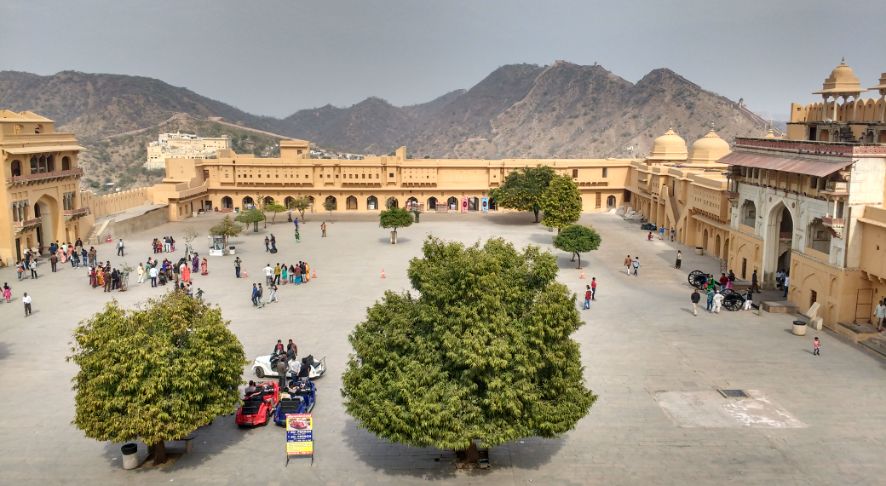
This place is a large courtyard where the army would assemble before departing for campaigns. Long gateways flank it, playing a crucial role in the fort’s defense and military activities. In Jaleb Chowk, they established stables and stationed sentinels in the top-floor rooms.
Lion Gate and Suraj Pol
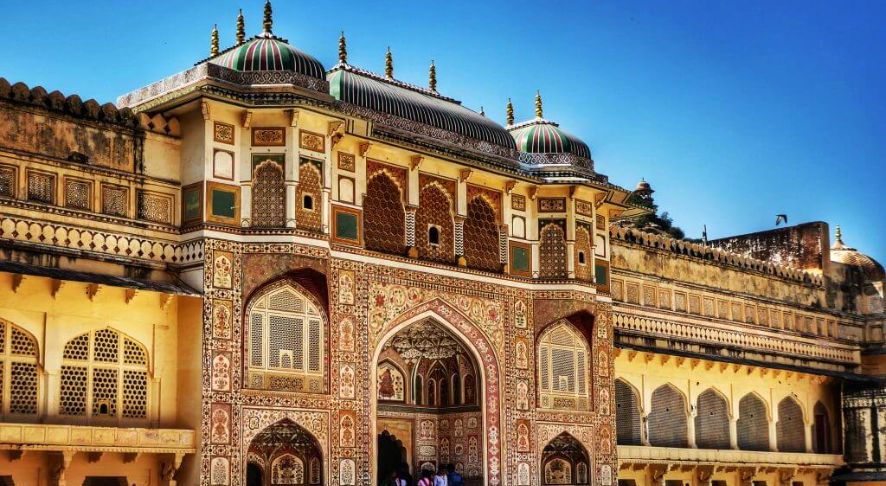
These impressive gateways are impressive in their architecture, but are historically significant because they were the main entrance for the royals to the fort.
Why should we visit Amber Fort Jaipur?
Amer Fort, is one of the most historical forts situated in the heart of Rajasthan and covers a vast part of the state. Apart from that, many significant reasons give us the chance to visit the beautiful Amber Fort.
1. Cultural Significance
Amer Fort and Amber Palace are steeped in ancient history, dating back to the late 16th century when Raja Man Singh I initiated their construction. The main reason to visit these sites is their strong connection to India’s past. They let you walk in royal footsteps and witness history firsthand.
2. Diving into Rajput Royalty
Once the residence of the Kachwaha dynasty, these historic structures offer insights into the lifestyles and traditions of Rajput rulers. Exploring the grand courtyards and halls lets visitors immerse themselves in the regal splendor of Royal Rajasthan’s rich history.
3. Ancient Marvels
The huge Amber Palace showcases the perfect blend of Rajput and old Mughal architectural styles, that is featuring ornate frescoes and expansive gardens. These historical sites serve as a real view of the architectural prowess of the passing time and a glimpse into the artistry and handicraft of the cultural era.
4. Historical Significance
The fort sits atop a hill, showcasing its formidable defenses. This highlights its role as a strategic stronghold in the region’s history.
5. Rich Heritage
Amer Fort and Amber Palace are more than just architectural structures. They are cultural heritage sites that host festivals and traditional reenactments. Exploring these cultural elements allows us to connect with the living traditions of Rajasthan and gain a deeper appreciation for its culture.
Is there any specific dress code to visit Amber Fort?
- Modest Clothing: Amber Fort Jaipur does not have a formal dress code. However, it is respectful to wear modest clothing when visiting historical or religious sites. Both men and women should wear clothing that covers the shoulders and knees, as people consider this attire appropriate for visiting.
- Comfortable Flats: Amber Fort Jaipur lots of walking and stair-climbing, so comfortable walking shoes or slippers are recommended.
- Removing Shoes is required: You may need to remove your shoes in some areas, especially when entering temples or historical buildings.
For Detailed Information, Visit Amber Fort
Things to know before visiting the Amber Fort Jaipur
- Hire a guide or not
It’s completely up to the tourists whether they want to hire a guide or not. If we want detailed information about the Amer Fort, its history, and cultural significance, then we can hire a guide. But if you plan to visit, you don’t need a guide. You can explore on your own and choose from the other available options. Enjoy with our loved ones.
- Don’t ride the elephants
Elephants are sacred as Lord Ganesh’s “savari” and have long served as a traditional mode of transportation. We must treat them with respect, as they are precious to both us and the environment. To make our way on the hill we can go for other options to reach the fort.
- Travel insurance
Travel insurance is essential for anyone planning to explore the world, especially in today’s uncertain global conditions. It helps reduce unexpected expenses and stress, making travel smoother and more secure.
Conclusion
Amer Fort and Amber Palace are not just buildings. They preserve Rajasthan’s heritage through festivals, rituals, and cultural reenactments year-round. Amer Fort Jaipur features several iconic attractions like the Diwan-e-Aam, or “Hall of Public Audience,” and the stunning Sheesh Mahal.
The Sukh Niwas offers a breezy climate inside the palace, adding to its charm. Visitors also experience the spiritual presence of Jai Mandir. These kind of places tells us more about our culture and how we are emotionally attached to it.
All Categories
